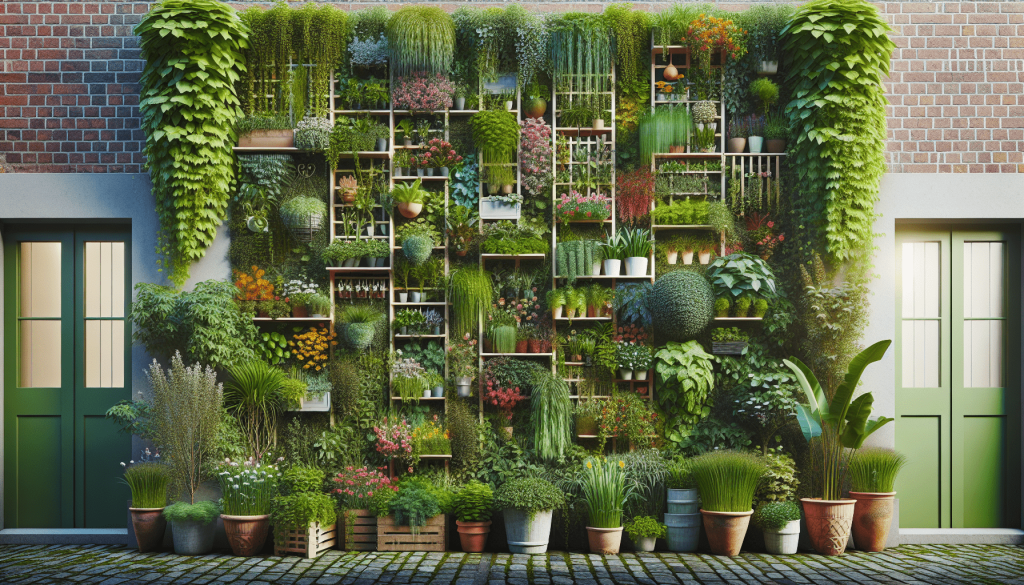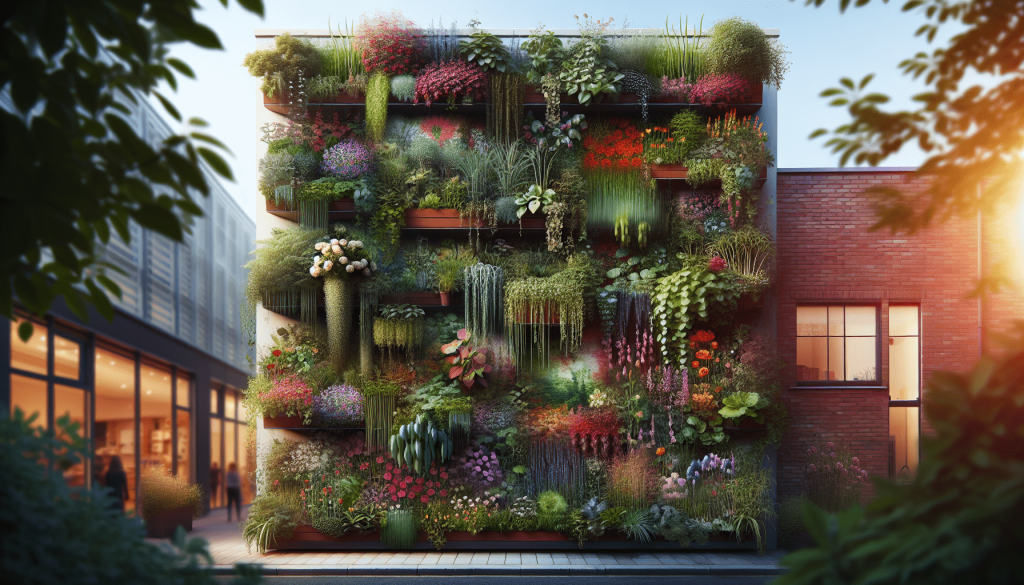This post may contain affiliate links. As an Amazon Associate, we may earn commissions from qualifying purchases.
Imagine transforming your small balcony or apartment wall into a lush, green oasis through the magic of vertical gardening. By utilizing vertical spaces, you can grow a variety of plants using trellises, wall-mounted planters, or hanging pots, making the most of limited areas. Vertical gardening not only maximizes your growing space but also brings numerous advantages such as improved air quality, aesthetic appeal, and easier access for maintenance and harvesting. Perfect for herbs like basil and mint, or even vegetables like cherry tomatoes and peas, vertical gardens can be as simple or as intricate as you desire. With a touch of creativity and the right plants, you can turn any small space into a thriving, green environment. Have you ever wondered how you can create a lush, green garden in a small space, like an apartment balcony or a tiny yard? The answer lies in vertical gardening! Vertical gardening isn’t just a space-saving technique; it’s also a way to bring nature into your life in a creative and manageable way. In this article, we’ll explore how vertical gardening works and why it’s such a fantastic option for small-space gardening. We’ll also dive into examples of suitable plants and structures that you can use to build your vertical garden.

How Vertical Gardening Works
Vertical gardening entails cultivating plants on a vertically suspended panel or using other structures like trellises or shelves. This technique is particularly beneficial when horizontal space is at a premium. It allows you to grow a variety of plants vertically rather than spreading them out over a wide area.
Basic Principles
The core idea behind vertical gardening is to use your available space more efficiently. By going vertical, you can grow multiple layers of plants, which is impossible in traditional ground-level gardening. This can be accomplished through various means:
- Wall-mounted Planters: These involve attaching pots or trays to a wall.
- Trellises: Ideal for climbing plants like vines.
- Hanging Baskets: Great for trailing plants.
- Stacked Planters: You can stack pots or planter boxes to create tiers.
Watering and Drainage
Watering is crucial in vertical gardens. Since the plants are elevated, conventional watering methods like soil soaking might not be effective. Use drip irrigation or self-watering setups that distribute water evenly across all levels. Drainage is equally important to prevent root rot. Make sure your plants are in well-drained soil and your vertical structure allows excess water to escape.
Soil and Nutrients
Quality soil is the backbone of any garden. In vertical gardening, lightweight, well-draining, nutrient-rich soil works best. You might need to fertilize more frequently since nutrients can be depleted faster in vertical setups.
Advantages of Vertical Gardening for Small-Space Gardening
The advantages of vertical gardening extend beyond just saving space. Let’s explore some of the wonderful benefits.
Space Optimization
One of the most obvious advantages is space optimization. With vertical gardening, you use the vertical space often overlooked in traditional gardening. This allows you to grow a significant number of plants in a constrained area.
Improved Airflow and Exposure
Vertical gardening can improve airflow around your plants, reducing the likelihood of fungal diseases. Moreover, plants grown vertically can get more sunlight as they are not overshadowed by other plants.
Accessibility and Maintenance
Vertical gardens are often easier to maintain. Tasks like watering, pruning, and harvesting become less cumbersome as you’re working at a more comfortable height.
Aesthetic Appeal
A vertical garden can be a stunning feature in any space. It adds layers of texture and color, essentially turning a bland wall or fence into a living piece of art.
Environmental Benefits
Vertical gardens play a role in reducing the urban heat island effect. They can act as natural insulators, absorbing sunlight and reducing the surrounding temperature. Additionally, vertical gardens can improve air quality by trapping dust and particulate matter.
Increased Yield
Because you’re maximizing your growing space, you can actually grow more plants and potentially increase your yield compared to traditional gardening methods.
Suitable Plants for Vertical Gardens
Not all plants are created equal when it comes to vertical gardening. Some plants adapt better to these vertical spaces than others. Here are some options to consider:
Climbing Plants
These plants naturally grow upward and are perfect for trellises and arches.
- Ivy: Hardy and fast-growing.
- Clematis: Beautiful flowers that can brighten any space.
- Honeysuckle: Fragrant and perfect for attracting pollinators.
Trailing Plants
These plants cascade downward, making them ideal for hanging baskets or the lower sections of a vertical garden.
- Spider Plant: Easy to care for and grows quickly.
- English Ivy: Versatile and can handle a variety of conditions.
- Sweet Potato Vine: Fast-growing with vibrant foliage.
Compact Edibles
Certain herbs and vegetables are suitable for vertical gardening due to their compact size.
- Lettuce: Grows quickly and doesn’t require much room.
- Spinach: Another leafy green that flourishes in small spaces.
- Herbs: Basil, rosemary, thyme, and mint are perfect for vertical gardens.
Ornamental Plants
These add a touch of beauty to your garden.
- Petunias: Available in many colors and are easy to grow.
- Begonias: Offer lush foliage and beautiful flowers.
- Pansies: Known for their vibrant colors and patterns.
Succulents and Cacti
These are ideal for vertical gardens due to their low maintenance needs.
- Aloe Vera: Useful and easy to grow.
- Sedums: Come in various shapes and sizes.
- Echeveria: Beautiful rosette-forming succulents.
Suitable Structures for Vertical Gardens
There are numerous structures you can use to build your vertical garden, ranging from DIY projects to commercially available solutions.
Wall-Mounted Planters
These are perhaps the simplest and most accessible form of vertical gardening. They involve attaching individual pots or planter boxes to a wall.
| Advantages | Disadvantages |
|---|---|
| Easy to install and maintain | Limited to small plants |
| Good for herbs and flowers | May require reinforcements for heavy pots |
Trellises
Trellises are excellent for climbing plants and can add visual interest to your garden.
| Advantages | Disadvantages |
|---|---|
| Great for vines and climbing plants | May not be suitable for heavy plants |
| Adds height and dimension | Requires sturdy installation |
Vertical Towers or Stacked Planters
These are specially designed towers or stacks where each layer accommodates a different planter.
| Advantages | Disadvantages |
|---|---|
| Utilizes space efficiently | Can be costly |
| Suitable for a variety of plant types | Might require frequent watering |
Hanging Baskets
These are perfect for trailing plants and can add a dynamic visual element to your garden.
| Advantages | Disadvantages |
|---|---|
| Great for ornamental plants | Limited to small, lightweight plants |
| Easy to move and rearrange | May need frequent watering |
DIY Structures
You can get creative and build your own structures using pallets, old bookshelves, or even PVC pipes.
| Advantages | Disadvantages |
|---|---|
| Cost-effective | Requires time and effort |
| Customizable to fit your space | Might not be as durable |

Practical Tips for Vertical Gardening
Location, Location, Location
Choose a location that gets ample sunlight but is also sheltered from strong winds. Most vertical gardens thrive in areas that receive at least 6 hours of sunlight daily.
Layering for Success
When you’re setting up your vertical garden, think about layering plants based on their sunlight and water needs. Plants that require more sunlight should be placed on the upper levels, while shade-loving plants can go lower down.
Regular Maintenance
Even though vertical gardens can be easier to maintain, they still need regular attention. Keep an eye out for pests, ensure your irrigation system is working properly, and remember to fertilize your plants.
Plant Rotation
Rotate your plants periodically to ensure that they grow evenly and get equal exposure to sunlight. This also helps to keep your garden looking fresh and dynamic.
Creative Use of Space
Don’t limit yourself to traditional gardening spaces. Look at railings, walls, fences, and even ceilings as potential areas to expand your vertical garden.
Case Studies and Real-world Examples
Balcony Vertical Gardens
Imagine a small balcony that overlooks a bustling city street. With limited floor space, a vertical garden along the railing and walls can create a serene and green oasis. You can grow trailing petunias in hanging baskets, place a tiered planter along the wall with herbs like basil and mint, and even use a small trellis for climbing ivy. This setup not only brings a touch of nature but also offers fresh herbs for your culinary needs.
Urban Rooftop Gardens
urban environments often lack personal green spaces, making rooftops an ideal location for vertical gardens. These gardens might include a combination of stacked planters and trellises growing vegetables like tomatoes, cucumbers, and spinach. They not only provide fresh produce but also help in cooling the building and enhancing air quality.
Indoor Vertical Gardens
For interior spaces with good natural light, vertical gardens can be an incredible addition. Think of a living room corner with a wall-mounted indoor garden featuring a mix of ferns, spider plants, and pothos. Such setups can improve indoor air quality, add aesthetic value, and create a calming environment.
Community Vertical Gardens
In urban areas where space is limited, community projects often turn to vertical gardening to maximize space. Community vertical gardens can be found in shared locations like school grounds, community centers, or urban parks. These gardens can bring people together, offering a place to grow flowers, vegetables, and herbs while educating the community on sustainable practices.
Challenges and Solutions
Weight and Stability
One of the primary challenges in vertical gardening is ensuring that your structure can support the weight of the plants, soil, and water. Always use sturdy materials and secure them well. If you’re unsure, consult a professional for advice on safely anchoring heavy structures.
Proper Watering
Watering can be tricky in vertical setups, as water naturally flows downward, which can leave upper plants dry and over-water the lower ones. Investing in a good drip irrigation system can solve this problem by providing a steady and even water supply to all levels of your vertical garden.
Pest Control
Because plants in a vertical garden are often packed together tightly, they can become a haven for pests. Regularly inspect your plants for signs of infestations and treat them promptly. Natural pest control methods, like introducing beneficial insects, can be effective.
Plant Compatibility
Not all plants grow well together. Be mindful of the specific needs of each plant type when you are planning your vertical garden. Group plants with similar watering and sunlight requirements together to ensure that all your plants flourish.
Conclusion
Vertical gardening is an innovative and efficient way to maximize your growing space, especially in small areas. It offers numerous benefits, from better space utilization and increased accessibility to visual appeal and environmental advantages. With a variety of suitable plants and structures, you can customize your vertical garden to fit your specific needs and preferences.
Whether you’re an urban dweller with limited outdoor space or someone looking to add more greenery to your home, vertical gardening provides a versatile solution that is both functional and beautiful. So why not start your vertical garden today and transform your small space into a flourishing sanctuary?
Happy gardening!








